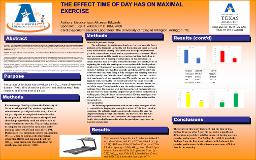
ATTENTION: The works hosted here are being migrated to a new repository that will consolidate resources, improve discoverability, and better show UTA's research impact on the global community. We will update authors as the migration progresses. Please see MavMatrix for more information.
Show simple item record
| dc.contributor.author | Isuo, Maurice | |
| dc.contributor.author | Edwards, Aliceson | |
| dc.date.accessioned | 2019-04-09T23:56:50Z | |
| dc.date.available | 2019-04-09T23:56:50Z | |
| dc.date.issued | 2018-12 | |
| dc.identifier.uri | http://hdl.handle.net/10106/27943 | |
| dc.description | KINE 4400 | |
| dc.description.abstract | **Please note that the full text is embargoed** ABSTRACT: INTRODUCTION: The circadian rhythm, also known as sleep/wake cycle, is a cycle that is constantly running as long as you are alive. The circadian rhythm is on a 24-hour clock that cycles between sleepiness and alertness at regular intervals. The circadian rhythms will affect physiological variables such as heart rate, oxygen consumption and blood pressure which can have a large impact on exercise performance. The Bruce Protocol is a treadmill test used to measure maximal oxygen consumption (VO2max).
PURPOSE: The purpose of this study was to evaluate the VO2max, Rate of Perceived Exertion (RPE), Time of exercise (min: sec), and Maximal Heart Rate measured at different times of the day.
METHODS: Five men (age 21±0.8 yrs.) from the University of Texas at Arlington (UTA) student population, volunteered to participate in this study. Each of the participants was required to complete the Bruce protocol. Which increases the speed and elevation progressively until the subject can no longer continue to exercise. The participants had to complete the study twice each, once in the morning before 10 AM and once after 3 PM. During each test, maximum oxygen consumption
(VO2max), time to fatigue, rate of perceived exhaustion (RPE), and maximal heart rate (HRmax) were measured. The alpha level for significance was set at p < 0.05.
RESULTS: The time until fatigue for the 5 males was 649±45.7 sec before 10 am, and 611 ± 37.7 sec after 3 pm; (p = 0.18). RPE was 16.6± 3.7 before 10 am, and 17.8± 2.2 after 3 pm; (p = 0.38). HR max was 192± 6.2 bpm before 10 am, and 187± 11.6 bpm after 3 pm; (p = 0.23). VO2max was 3.78± 0.52 L/min before 10 am, and 3.69± 0.42 L/min after 3pm; (p = 0.77).
CONCLUSION: The results of this study indicated that the time of day (before 10 am or after 3 pm) did not make a significant different on any of the variables measured during maximal exercise performance. | en_US |
| dc.description.sponsorship | Faculty Sponsor: Judy R. Wilson | en_US |
| dc.language.iso | en_US | en_US |
| dc.publisher | The University of Texas at Arlington | en_US |
| dc.subject | Maximal exercise | en_US |
| dc.subject | Time of day | en_US |
| dc.title | The Effect Time of Day has on Maximal Exercise | en_US |
| dc.type | Presentation | en_US |
| dc.publisher.department | Department of Kinesiology | |
Files in this item
- Name:
- IsuoEdwards poster template 2.pdf
- Size:
- 538.7Kb
- Format:
- PDF
- Description:
- PDF
This item appears in the following Collection(s)
Show simple item record


